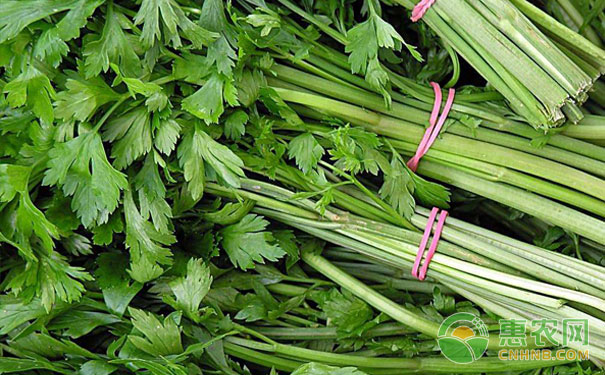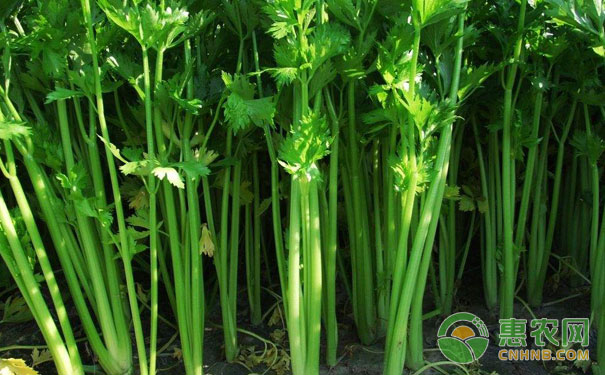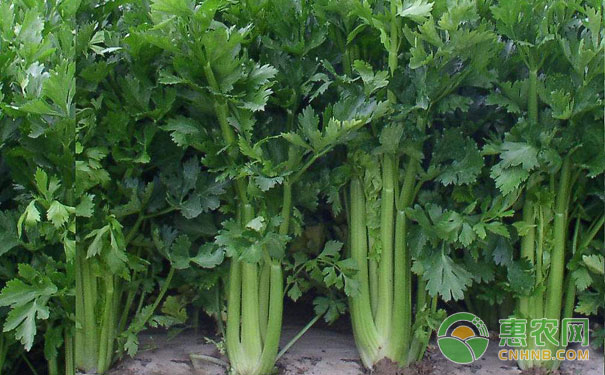Celery planting technology: how to grow autumn and winter celery
Celery is one of the main leafy varieties, which can be used for protection in the autumn and winter. When the celery is listed in the autumn and winter, during the Spring Festival of New Year's Day, it is in the off-season of vegetable supply, and the economic benefits are considerable.

1 èŒ¬å£ arrangement
According to the time of market, autumn and winter celery is cultivated in early to mid-August, and the seedling age is 60-70 days. It is planted from early to mid-October and harvested around 75 days.
2 variety selection
For the cultivation of parsley in Beijing, you can use Jinnan Shiqin No. 1, stick celery, chrysanthemum big leaf, celery, horse plant celery, iron stalk celery and so on. Celery can be selected from Italian winter parsley, tender and crisp, high Utah 52-70, Florida 638, Ventura and other varieties.
3 nursery
3.1 Seed treatment
It is carried out 7 to 8 days before sowing. (1) Disinfection. The seeds were soaked in constant temperature water at 48 °C for 30 min, stirring constantly, and then taken out and placed in cold water to soak seeds. (2) Soaking seeds. Soak seeds in cold water for 24 h, wash them several times during soaking, to facilitate water absorption. (3) germination. The first method is to wash the soaked seeds with water, remove the drained water, wrap it with gauze with good permeability, cover with a towel, and germination at 15-20 °C, usually after 5-6 d. 30% to 50% of the seeds can be sown when they are germinated and white; the second method is to put the seeds after soaking in a refrigerator at about 5 °C, and rinse them once a day with water every morning and evening. After 2 days, the seeds are spread in the light environment, rinsed twice with water every day, and then blown for 5-10 minutes after each flush to prevent excessive moisture on the surface of the seeds and affect the germination. Generally, it can be germinated after 6-8 days. The third method is to soak seeds with 5 mg/L gibberellic acid solution for 12 h, wash them with water for 8 h, then spread them in a light environment at 15-22 °C. Rinse with water once in the morning and evening, and shoot after the shoots are exposed.
3.2 Sowing
The sowing time of celery in autumn and winter is generally from early August to mid-August. The planting amount of 667 m2 in the field is 80-150 g. The seeding method is divided into two types: seeding and spreading.
Because the celery seeds are small, some soot or sand should be mixed during sowing to facilitate seeding. Before planting, pour the bottom water, and use the 66 to 7 cm line spacing to dig the groove on the 畦 surface, and spread the seeds evenly in the ditch, covering 0.3~0.5 cm thick fine sand. Sowing is best done on cloudy days or in the afternoon to prevent sunburn from sprouting in the hot sun.
3.3 Seedling management

Cover the shade net after sowing to reduce the temperature of the seedbed to facilitate emergence. The management points of the current autumn celery are mentioned in the above mentioned seedlings to keep the soil in the seedbed moist. When the young shoots are topped, the water can be lightly poured once. After the seedlings are out, the soil is kept moist, and the water is poured once every 2 to 3 days, morning and evening. The seedling temperature is 15 to 20 °C during the day, not exceeding 22 °C, and not lower than 8 °C during the night. When the seedlings grow 3 to 4 leaves, they are divided into seedlings, and 6 to 7 cm see a square seedling. Seeds can also be divided into 128-well trays. When the seedlings are 5 to 6 leaves, they are planted. This celery seedling age is 50 d, and celery is 60 to 70 d.
4 Planting and field management
4.1 Site preparation
Planted in early October and early November. Applying about 5,000 kg of farmyard manure per 667 m2 before planting can not only loosen the soil but also supplement trace elements. After the base fertilizer is applied, turn it over again to mix the fertilizer with the soil. Then ridges, the ridge distance is 70 cm, and the ridge height is 10-15 cm.
The seedbed is watered once every 1-2 days before planting to avoid damage to the roots. Planting 2 rows per ridge, row spacing 35 cm, cultivating large trees, plant spacing 30 cm, planting 6,000 to 7,000 plants per 667 m2; cultivating medium-sized trees, plant spacing 25 cm, planting 7 000-8 000 plants per 667 m2. Planting a single plant, watering and slowing down the seedlings after planting.
4.2 Field Management
4.2.1 Temperature regulation
The greenhouse temperature is controlled at 15 to 25 °C during the day and 10 °C during the night. When the room temperature exceeds 25 °C, the temperature can be adjusted by the air release, and the temperature is lowered at a low temperature and the temperature is raised at a high temperature. In the late growth stage, in order to promote the rapid growth of celery and increase the yield, the temperature can be appropriately increased. The temperature is controlled at 20 to 25 °C during the daytime. With the decrease of the outdoor temperature, the temperature in the nighttime greenhouse should be increased to 10 °C to strengthen the insulation to prevent freezing damage.
4.2.2 Fertilizer and water management
After planting, seedlings should be planted for 7 to 15 days. During this period, the leaves are loosened when the heart begins to grow. After the seedlings are finished, the ridges are not dried or watered, and the ridges are kept dry to improve the ground temperature and promote rooting, laying a good foundation for rapid growth in the middle and late stages.
When celery grows to about 30 cm and 40 to 45 cm, it is combined with watering for topdressing. Nitrogen is the main factor, supplemented by potassium fertilizer. 20 kg of urea and 7.5 kg of potassium sulfate are applied per 667 m2. More celery fertilization techniques can be consulted.
4.3 Disease prevention
The physiological diseases of celery include heartburn, hollowness, and boron deficiency. After the onset, it affects both growth and quality. To prevent heartburn, please pay attention to avoid high temperature and drought, nitrogen, potassium, magnesium and other fertilizers should be appropriate, if necessary, 0.5% potassium chloride or potassium nitrate aqueous solution can be used for foliar spray. Avoid cultivation on sandy soil that prevents hollowness. Boron deficiency may lead to abnormal hypertrophy, shortening of the petiole, and bending to the medial side, browning of the medial tissue, necrosis of the heart. Precautions can be applied to 1 kg of borax per 667 m2 or foliar spray with 0.1% to 0.3% borax aqueous solution.

In addition, greenhouse cultivation of celery should pay attention to temperature and humidity regulation to prevent leaf spot, spot blight, early blight and sclerotinia disease. Once the diseased plant is found, it should be removed immediately and controlled with a chemical to prevent spread. Generally, the drug is administered once every 7 to 10 days, and the drug is administered continuously for 2 to 3 times. For leaf spot disease, 75% chlorothalonil WP 600 times solution or 50% carbendazim WP 800 times solution can be used for prevention and control; spot blight is treated with 3% agricultural anti-120 water agent 100 times solution, 75% Phytosanitary wettable powder 600 times liquid and other chemical control; 77% of the early blight can kill 500 times liquid, 3% agricultural anti-120 water 100 times liquid, or 50% carbendazim WP 500 times liquid For sclerotinia sclerotiorum with 50% keering WP 1500 times solution, 50% chloramphenicol 1 000 times solution, or 50% sclerotin net 1 000 times solution spray; for soft rot or heart rot In the early stage of the disease, 72% agricultural streptomycin or neomycin (3 000 ~ 4 000 times solution, or 14% copper ammonia solution 300 times solution, or 30% DT suspension 500 times solution spray is used for prevention and treatment.
Hpmc Empty Vegetarian Capsules,Vegetarian Empty Capsule,Empty Color Vegetable Capsule,Medical Empty Vegan Capsules
Ningbo Jiangnan Capsule Co., Ltd. , https://www.ningbocapsule.com
